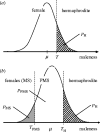Sex inheritance in gynodioecious species: a polygenic view
- PMID: 16096091
- PMCID: PMC1559863
- DOI: 10.1098/rspb.2005.3168
Sex inheritance in gynodioecious species: a polygenic view
Abstract
Gynodioecy is defined as the coexistence of two different sexual morphs in a population: females and hermaphrodites. This breeding system is found among many different families of angiosperms and is usually under nucleo-cytoplasmic inheritance, with maternally inherited genes causing male sterility and nuclear factors restoring male fertility. Numerous theoretical models have investigated the conditions for the stable coexistence of females and hermaphrodites. To date, all models rest on the assumption that restoration of a given male sterile genotype is controlled by a single Mendelian factor. Here, we review data bearing on the genetic determinism of sex inheritance in three gynodiecious plant species. We suggest that restoration of male fertility is probably best viewed as a quantitative trait controlled by many loci. We develop a threshold model that accommodates an underlying polygenic trait, which is resolved at the phenotypic level in discrete sexual morphs. We use this model to reanalyse data in Thymus vulgaris, Silene vulgaris and Plantago coronopus. A simple Mendelian inheritance of sex determinism is unlikely in all three species. We discuss how our model can shed additional light on the genetics of restoration and point towards future efforts in the modelling of gynodioecy.
Figures


Similar articles
-
Multiple CMS-restorer gene polymorphism in gynodioecious Plantago coronopus.Heredity (Edinb). 2004 Aug;93(2):175-81. doi: 10.1038/sj.hdy.6800490. Heredity (Edinb). 2004. PMID: 15138454
-
Modeling gynodioecy: novel scenarios for maintaining polymorphism.Am Nat. 2003 May;161(5):762-76. doi: 10.1086/374803. Epub 2003 May 2. Am Nat. 2003. PMID: 12858283
-
A cost of restoration of male fertility in a gynodioecious species, Lobelia siphilitica.Evolution. 2002 Nov;56(11):2178-86. doi: 10.1111/j.0014-3820.2002.tb00142.x. Evolution. 2002. PMID: 12487348
-
Do recent findings in plant mitochondrial molecular and population genetics have implications for the study of gynodioecy and cytonuclear conflict?Evolution. 2008 May;62(5):1013-25. doi: 10.1111/j.1558-5646.2008.00363.x. Epub 2008 Mar 1. Evolution. 2008. PMID: 18315572 Review.
-
Merging theory and mechanism in studies of gynodioecy.Trends Ecol Evol. 2007 Jan;22(1):17-24. doi: 10.1016/j.tree.2006.09.013. Epub 2006 Oct 6. Trends Ecol Evol. 2007. PMID: 17028054 Review.
Cited by
-
Sex-ratio evolution in nuclear-cytoplasmic gynodioecy when restoration is a threshold trait.Genetics. 2007 Aug;176(4):2465-76. doi: 10.1534/genetics.107.076554. Genetics. 2007. PMID: 17717197 Free PMC article.
-
Genetic determination of male sterility in gynodioecious Silene nutans.Heredity (Edinb). 2011 May;106(5):757-64. doi: 10.1038/hdy.2010.116. Epub 2010 Sep 1. Heredity (Edinb). 2011. PMID: 20808324 Free PMC article.
-
Recent advances in the study of gynodioecy: the interface of theory and empiricism.Ann Bot. 2009 Sep;104(4):611-20. doi: 10.1093/aob/mcp141. Epub 2009 Jun 10. Ann Bot. 2009. PMID: 19515690 Free PMC article. Review.
-
Temperature-dependent benefits and costs of cytoplasmic male sterility in snail Physa acuta.Proc Biol Sci. 2025 Jan;292(2038):20241762. doi: 10.1098/rspb.2024.1762. Epub 2025 Jan 15. Proc Biol Sci. 2025. PMID: 39809308
-
Effects of nuclear genomes on anther development in cytoplasmic male sterile chicories (Cichorium intybus L.): morphological analysis.ScientificWorldJournal. 2015;2015:529521. doi: 10.1155/2015/529521. Epub 2015 Mar 15. ScientificWorldJournal. 2015. PMID: 25861678 Free PMC article.
References
-
- Assouad, M. W. 1972 Recherche sur la génétique écologique de Thymus vulgaris L. Thèse de Doctorat es Sciences, USTL, Montpellier, France.
-
- Bailey M. A cost of restoration of male fertility in a gynodioecious species, Lobelia siphilitica. Evolution. 2002;56:2178–2186. - PubMed
-
- Bailey M.F, Delph L.F, Lively C.M. Modelling gynodioecy: novel scenarios for maintaining polymorphism. Am. Nat. 2003;161:762–776. - PubMed
-
- Belhassen E, Dommée B, Atlan A, Gouyon P.H, Pomente D, Assouad M.W, Couvet D. Complex determination of male sterility in Thymus vulgaris L.: genetic and molecular analysis. Theor. Appl. Genet. 1991;82:137–143. - PubMed
Publication types
MeSH terms
LinkOut - more resources
Full Text Sources

